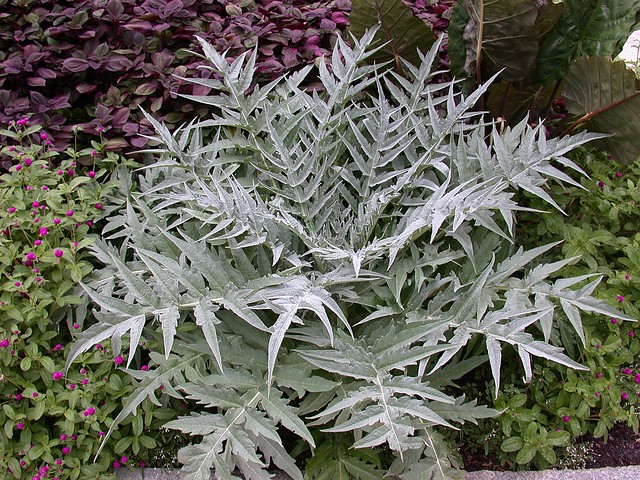
Cardoon (Cynara cardunculus), National Museum of Natural History gardens
I don't normally do a lot of walking in mid-summer, but we've had such uncharacteristically pleasant summer weather for the past several weeks that I can't use my usual excuse of heat and humidity to avoid a bit of exercise. So come with me on a Friday evening as I walk from work in downtown Washington, DC to join my husband for dinner at a restaurant on 14th Street near Logan Circle. This month marks 23 years since we moved here from a small town in upstate New York, so forgive me if I wax a bit nostalgic along the way!
Little did I suspect when I arrived here in 1991 that I would stay so long. The photo above was taken in a garden at the National Museum of Natural History, where I've worked the entire time I've been here. I wish it gave a better sense of scale; this plant was very big--about 3 feet (ca. 1 m) across--and quite impressive. It's hard to believe it's just a giant artichoke, but it fits right in with its tropical companions. (For more about these gardens, see Smithsonian Gardens, part 1: National Museum of Natural History.)
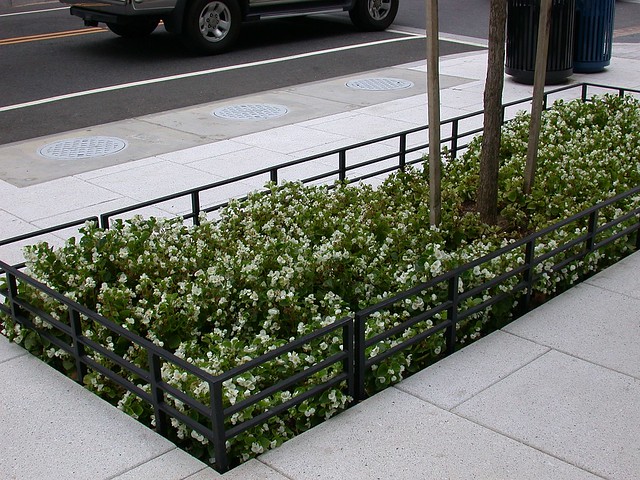
Begonias, downtown Washington, DC
The city has come a long way since 1991, and downtown in particular has cleaned up quite a bit. I have to give the city credit for trying to beautify itself, but the begonias I see planted in downtown Washington, DC usually remind me that there are begonias that I hate. Semperflorens a.k.a. "wax" begonias, hybrids derived from the Brazilian species B. cucullata and several closely related species, are among the most generic and boring of all bedding plants. The plants are ubiquitous and seem to have been specifically bred to utterly lack character or individuality. But at least they can provide some color; in this particular space, any color other than white would have been better, but I would rather have seen vinca (Catharanthus roseus), another ubiquitous bedding plant here but with a bit more personality and performing well in our summer heat. I'm happy to see local growers embracing the newer and far more dramatic "dragonwing" hybrids but we still have a long way to go to educate the gardening public about the many other worthwhile begonias that are available.
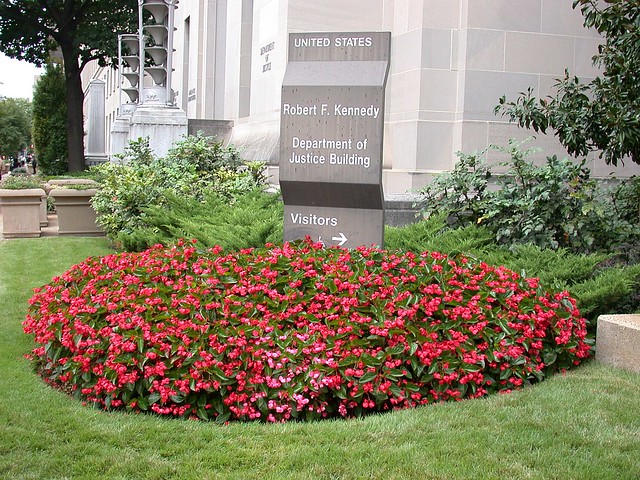
Dragonwing begonias, Department of Justice building (October 2012)
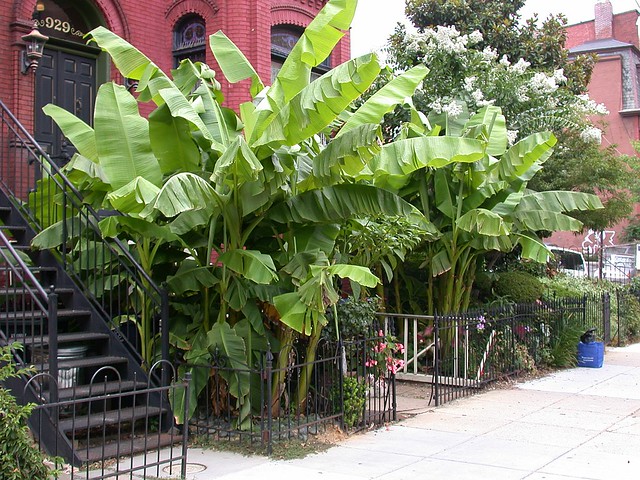
Bananas, Shaw neighborhood
Heading north from downtown through the Shaw neighborhood, I stopped to check on some hardy bananas (Musa basjoo) just a block from the Washington Convention Center. I'm not the first person to notice them (in fact a friend tipped me off to them in the first place) and they seem to be popular photographic subjects as I had to wait while another passerby snapped some shots of his girlfriend posing in front of them. I'll admit I'm a bit envious; these bananas came back a lot stronger than my own did, which are are usually pushing 20 feet by August but this year are barely above my head. Maybe it's just because they're on my radar now, but I'm seeing a lot more hardy bananas around town than when I first moved here in 1991. In my opinion, plants like this are a better fit for our subtropical summers than many of the more common garden plants, with the advantage that they continue to look good in late summer and into the fall.
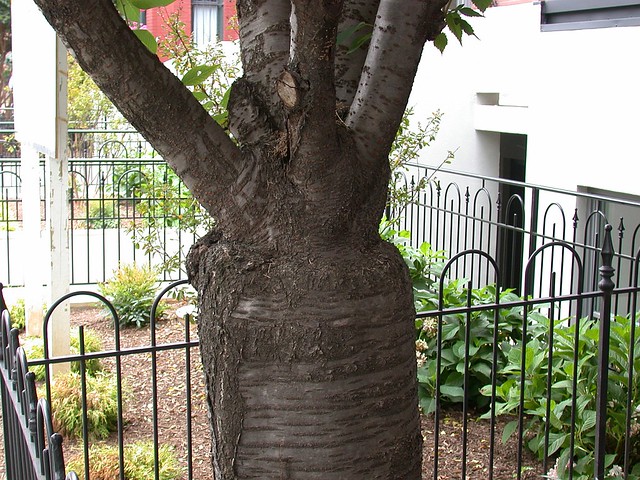
Grafted cherry, Shaw neighborhood (another view)
You just never know what you're going to find when you go for a walk in the city. Just down the block from the bananas, I came across this rather unfortunate grafted cherry. Most commercially produced ornamental cherries are grafted, with the graft union usually inconspicuous if not completely invisible, but this one is more like Frankenstein's monster, assembled from mismatched parts with the thick trunk sprouting a ridiculously small crown. I have no idea why the tree grew like this.
Garden, Shaw neighborhood
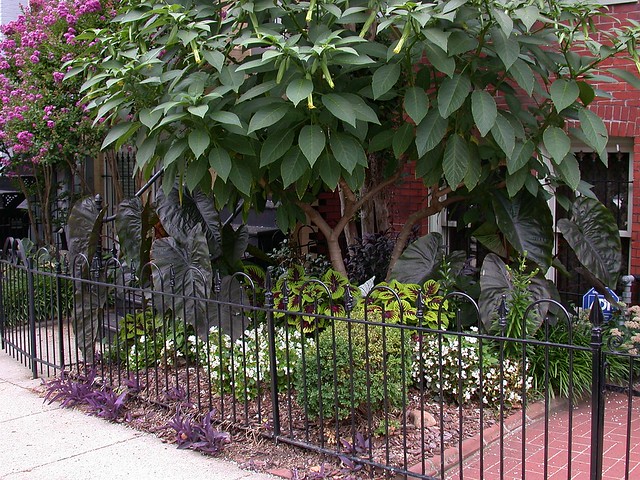
Garden, Shaw neighborhood (closeup)
Just a few blocks away, I found this tiny front garden with an enormous brugmansia, probably the biggest I've ever seen in Washington. Although brugmansias may occasionally overwinter here, it's hard to believe it survived this past winter, and certainly not with any of its stem intact. It promises to be spectacular in bloom and I'll have to go back some evening to see the flowers open!
Fig, Shaw neighborhood
Many of the area's figs (including my own) were killed to the ground by this past winter. Most are re-sprouting, but here and there I've seen a few individuals that were untouched. This huge individual (probably the hardy cultivar 'Celeste' but I'm not a fig expert), wedged between two buildings, is apparently growing in a very good microclimate! It's also a reminder of just how big figs can get, and as I eye my own figs, sprouting prolifically from their stumps, I'm wondering whether I really have that kind of real estate in my garden. I love figs, and was disappointed that my own trees were so badly damaged, but I have to confess it's a bit refreshing to have a little more open space and a bit more sun in my "sunny" bed this year!
House, Logan/Shaw
The Logan Circle neighborhood, a few blocks east of Dupont Circle and sometimes included in Shaw (especially on older maps), was dubbed "Dupont East" by creative real estate agents in the early 1990's to overcome the neighborhood's stigma of crime, prostitution, and drug dealing. For years, Logan Circle was an up-and-coming neighborhood that never quite up and came, but then practically overnight, finally did. Even at its worst, these beautiful old houses, especially around the circle itself, stood proud and hinted at what this city was like a century or more ago. Now it's once again one of the most desirable (and expensive) neighborhoods in the city.
General Logan, Logan Circle park
Many people seem to have a mental snapshot of what Washington was like 20 years ago, but this is no longer that city. It's hard for those outside the city, especially anybody who hasn't visited here in recent years (or seen any of Washington away from the monuments and museums downtown) to appreciate how much this city has changed in the last 20 (and especially the last 10) years.
Golden Warrior, Embassy of the Republic of Kazakhstan (Logan Circle/Dupont)
It's a shame that most tourists don't get off the beaten touristy track to see the rest of the city, where people actually live. And there are always surprises! In a city practically overflowing with monuments, memorials, and statues, one of my favorites is the "Golden Warrior" in front of the Embassy of the Republic of Kazakhstan. The warrior stands on a winged snow leopard with a bow in one hand and a falcon on the other. When was the last time you saw a statue that awesome?
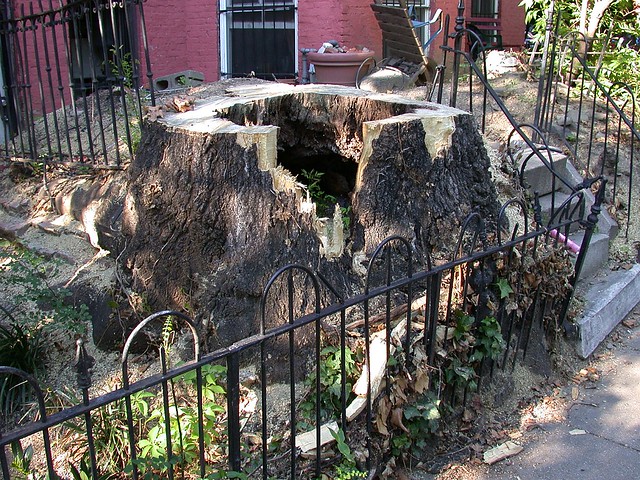
Tree stump, Logan Circle neighborhood
But everywhere, there are reminders of a recent past when the city was neglected and decaying. This stump is all that is left of an enormous Ailanthus altissima, euphemistically named "tree of heaven", one of the weediest of weed trees of Washington, DC and often more crudely called "ghetto palm" because of the palm-like appearance of the rapidly growing juveniles that sprout in the most hostile or unlikely of environments. Ailanthus is one of the weeds I've struggled with in my own garden, both from the fast-growing seedlings--the female trees produce thousands of winged seeds--and from root suckers I find popping up in my garden, with the nearest tree several houses away. So when I'm watering and fertilizing my own garden, I'm apparently watering and fertilizing my neighbor's weed trees, as well.

Ailanthus stump
Washington, DC is a city with a past, a present, and a future. Despite being an ailanthus, this stump makes me feel a bit sad as it brings back memories of a friend who lived in the Logan Circle neighborhood when I first moved to Washington. He pointed out this particular tree to me on an evening walk when this was still a neighborhood where one felt nervous walking after dark; even then it was one of the biggest trees in the neighborhood. It was a shock to see it finally felled, although it's clear that, being rotted out and hollow, it was a disaster waiting to happen. But peer inside and it's equally clear that, while it may have been cut down, this tree is not going down without a fight! There's something fitting about a tree in Washington, DC sprouting new growth from within its own gaping, and seemingly fatal, wound.
Store on 14th Street
Finally we arrive on 14th Street, where dozens of new shops and restaurants have opened in recent years, representing one of the most rapid and remarkable neighborhood transformations I've seen in my 23 years here. This stretch was devastated in 1968 by riots following the assassination of Martin Luther King, Jr.; the area languished for years but now it's one of the trendiest parts of town, not only for its restaurants but as the city's new design district.
Food is one of my other interests, and while this isn't a blog about food, that interest will occasionally come through. For years it seemed that Washington, DC was a culinary wasteland with just a few truly exceptional (but always very pricey) restaurants here and there, but in the last few years a huge number of new restaurants have opened up, many of them very good. Good Italian food was especially hard to come by so it was especially satisfying that last night's walk ended with dinner at Etto, a tiny Italian restaurant on 14th Street.
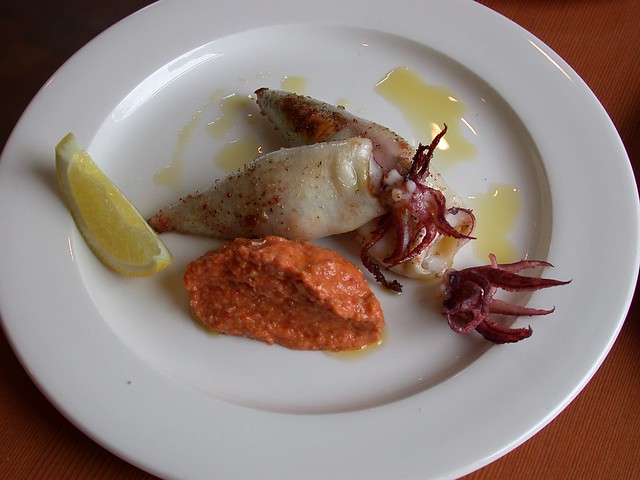
Stuffed squid at Etto
Did you like this post? Please click on the share buttons below to share on Facebook, Twitter, or Pinterest!

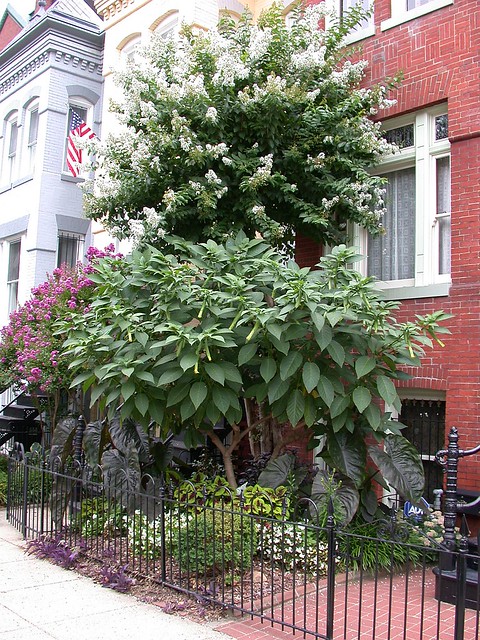
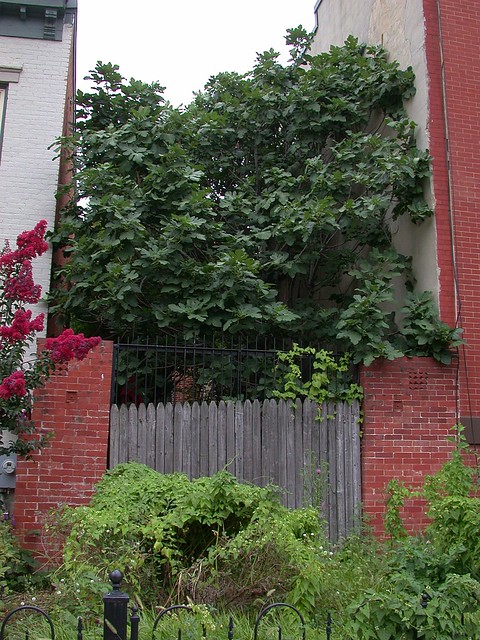

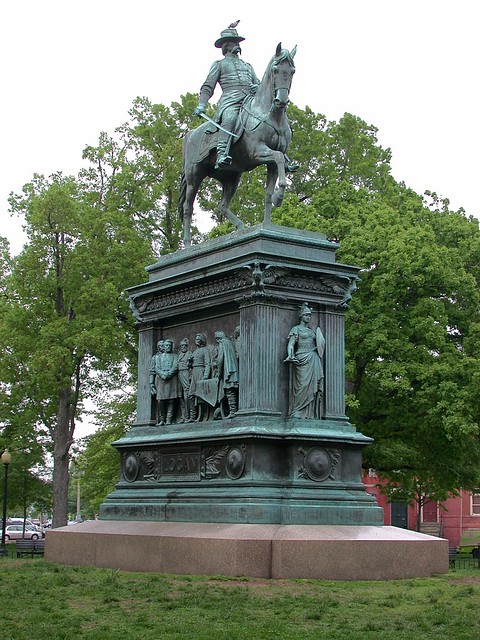
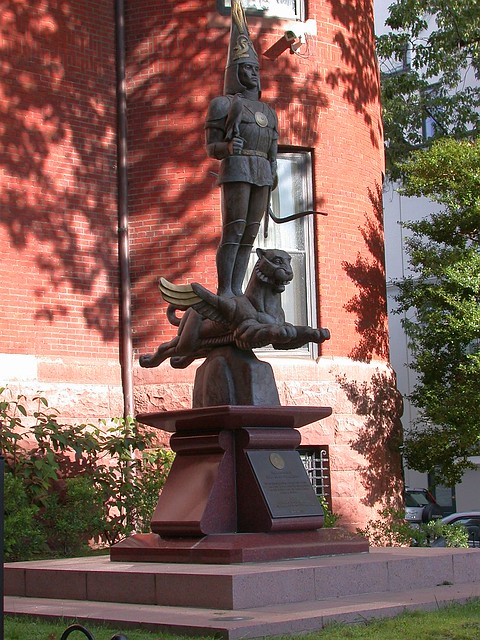
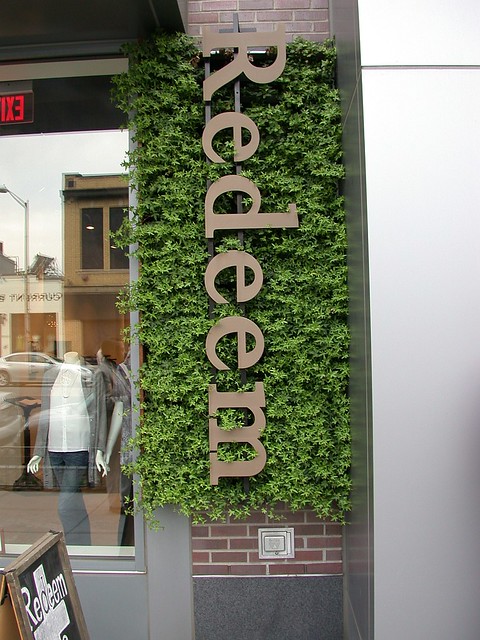
Thank you for taking us along on a fascinating walk! The brugmansia is amazing, there must be some form of heat escaping from the building and it's surrounding if it over wintered in situ. Also those bananas looks great where they are.
ReplyDeleteI doubt that it was overwintered in the ground, especially considering how cold the winter was. The roots might survive a warm winter (especially with a heavy mulch) but I doubt the stems would. But I just don't know; otherwise it was planted as a very large plant!
DeleteNice walk-about! When I'm in DC around the museums, I tend to focus on the big concrete security barriers that COULD have large planters full of lovely things. There are a few of those, but they are generally planted with boring old liriope - what a waste! Up for some guerilla gardening with me next year?
ReplyDeleteYes, I've had the same thought. I guess the liriope is better than nothing (and about as low-maintenance and trouble-free as you can get) but it's refreshing to see some here and there planted with petunias, and others with a mix of sedums and other succulents.
DeleteThanks for the walking tour. I love Washington, D.C. and we take a weekend trip there every April. We also sometimes visit at other times to catch a show at the Kennedy Center. The city is so walkable and so beautiful. That Brugmansia must be heck to move every year :-)
ReplyDeleteI've gotten a lot of questions about that brug and I'm still scratching my head over it. I just can't believe it was overwintered in the ground but the alternatives are daunting! BTW I love the terrace at the Kennedy Center and the view of the river!
Delete